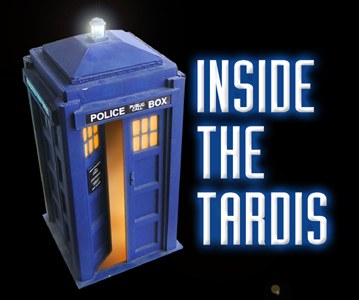


I wanted to do a few specific things with this segment. I had purchased this very nice Joe-sized sculpture of Horus, the Falcon-god of Egypt, which is actually an aquarium ornament. And it reminded me of "The Maltese Falcon", one of my favorite vintage movies. All I had to do was paint it black. And I'm a huge fan of the Noir detective fiction by Hammett and Chandler. I'd seen "The Maltese Falcon" but never read it. During the scripting of this one I read the book.And of course I re-watched the movie.
Note how my title screen tries to mimic the signature graphic from the film:
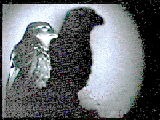 |
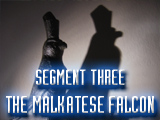 |
|
Shot from the film
|
My title card
|
I wanted to make a parody of "The Maltese Falcon" but without redoing it entirely. I opted to take one scene from the story and involve my cast in it somehow.
The second thing I wanted to do was introduce another renegade Timelord. But not just any Timelord. I wanted him to be a pastiche of Hawk from Robert B. Parker's "Spenser" novels which I had been reading rather voraciously the last two years. I had a perfect figure to play the part and dressed him up to look quite sharp. And as a play on the name Hawk, I chose the Falconer. After all, most Timelords have monikers that fit this style. The Doctor, the Master, the Rani, the Monk, etc. I thought not only would this guy be called the Falconer, but he would be a falconer. This fit into the story perfectly as the dingus in this story was a falcon. I figured at one point the Doctor would consult the Falconer on what to do about the Falcon he had found.
One piece of feedback I recall reading by someone who had read my story complained about the racism in my story because of this Falconer character. On its face, the scene with the Falconer does seem that way - unless you know the character of Hawk. Hawk is an old friend of Parker's detective Spenser. He is a streetwise, but highly sophisticated enforcer. He drives expensive cars, dresses expensively, but speaks as if he comes from the street. He speaks without prepositions for the most part, except when there's real trouble. Spenser knows Hawk is worried when he drops his affected street speak and actually uses prepositions and full sentences.
For the unedcuated, yes, Falconer seems like a racist stereotype, and perhaps so is Hawk, but my character is supposed to be a very close parody of Hawk, so I guess some of the stereotyping carries over.
But this story does more than just parody some of my favorite detectives. It shows that someone is in direct competition with the Doctor in finding the pieces of the Key to Time. Someone is interfering...
This story was rather complicated, so I had to do storyboards that closely matched the script. This, I tried to follow as closely as possible. Again, though, reality often has a serious effect on how the actual shots are laid out and filmed.
|
Click any image for a larger one.
|
This Segment also introduces a nifty time paradox that I have a hard time even explaining, but I'll try.
The uncredited Captain Jacobi (the captain from "The Maltese Falcon" who brings the bird from the freighter from Hong Kong to Spade's office after having been shot a few times by Gutman's enforcer, Wilmer) brings a black bird to Spade's office. This, we know to be the real Key Segment. We know this because the Doctor's locator spots it while Jacobi lies dead on the floor.
Then a dark, mysterious figure enters the scene and replaces the bird with an exact duplicate. Then the one the Doctor gets is a fake, placed on the desk by the dark figure.
Then the Doctor has the fake, takes it to the Falconer who advises him to just go back in time and take the original from the Egyptian chamber it was originally located in. He replaces the real thing with a fake.
This means an impossible thing happens. The original key segment, verified by the Doctor as the real deal, is not the original as the Doctor has removed the original from its home time line and replaced it with a duplicate. Therefore the duplicate went up through time and ended up in Spade's office, but the duplicate would never have signaled the Doctor's locator, and in effect, the dark figure replaces one duplicate with another.
But until the Doctor went back in time to retrieve the original, the one in Spade's office is the original... it doesn't make sense, so don't bother trying to make it make sense. It just doesn't.
So why would the dark figure go through the trouble of making a duplicate in Spade's office and not just steal the dingus and be off with it?
I make the claim that the dark figure hopes he can distract the Doctor for long enough to get away with the Segment without being pursued closely by the Doctor.
But since the Doctor is a Timelord, delaying him means nothing. It wouldn't work anyway. Because the Doctor could theoretically meet him at any point whether it be seconds, hours or weeks later when he discovered the fake. In theory. Of course the Doctor's TARDIS is never too reliable, and the Master probably knows this from past encounters with the Doctor.
In this story, the Doctor suggests his companions wear appropriate outfits in order not to draw too much attention to themselves in 1940s San Francisco. How did they do?
In this story, Elannuir's body has been replaced with a BBI Cy Girl body. It had white gloves and fit the kimono-dress better. I figure I can swap out bodies as often as I want as long as the head stays the same.
The kimono-dress came with a Mary-Jane Watson figure from the first Spiderman movie.
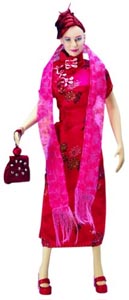 |
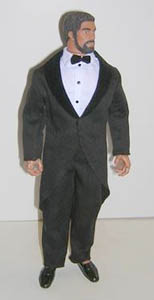 |
|
Mary Jane Watson
|
Ken Tuxedo
|
Sir Edmund opts to wear a suit he thinks will go un-noticed in 1940s San Francisco. He... doesn't quite achieve the effect he's going for, but it is a worthy try. And it gave the Doctor a great line about how ridiculous the scarf looked.
Note that Sir Edmund still has the black sack with him, and in lieu of his sword he carries a walking stick, a good item for defense if necessary. His top hat seems out of place in the 1940s.
The tuxedo is a Ken wedding tux, and is one of the nicest I've seen. It has long tails. (I got married in tails.) The hat and walking stick came from a yard sale where someone was selling craft supplies. This was a kit that came with styrofoam balls to make a snowman or some other nonsense. I noticed it should fit a smaller-headed GI Joe well, and I was right.
The opening scene shows the Doctor welcoming Elannuir to his TARDIS. She is, of course, amazed that it is larger on the inside than the outside. But as the Doctor points out, she will indeed get used to that.
We find Elannuir still a little wary of her new companions, but thankful to be away from her previous situation. In the previous Segment, we see Elannuir's surprise when the Doctor hands her back her weapon. She obviously doesn't trust people easily. But the Doctor went a long way to earn her trust back on Terratannis.
On the coat rack is a Star Wars AT-ST Driver's helmet, among other things, including McCoy's red umbrella (made of copper wire, black cloth, a bead and red paint.)
While Elannuir is away, Sir Edmund takes this opportunity to ask the Doctor just what it is he's playing with. In the last episode, I think you can tell he wanted to ask, but was as yet a little too shy.
Anyway, the Doctor is playing with the Rubik's Cube, a working miniature I found in a 25 cent machine. I have a few of these, one remains unmixed-up so I can pull gags like this from time to time.
Note: I used to be able to solve the cube in less than 20 seconds. I never learned on my own, I learned from a book. Once memorized, and if the cube is nicely lubed up, a person can solve it in a very short time, consistently.
Of course it's ridiculous that Sir Edmund solves this puzzle so quickly, but perhaps that's an indication of just how clever the knight is. Meanwhile, ironically, the Doctor is struggling to put the Key to Time's segments together, with the excuse that Romana did all the solving work before... (not quite true, though it makes a good excuse to his fellow companions.) Actually, in City of Death, Romana opens a Chinese Pulzzle Box with ease, to the chagrin of its owner.
I love the Doctor's expression as Sir Edmund hands back the puzzle, completed.
The TARDIS screen's shot of 1940s San Francisco is actually downtown Boston, just south of South Station, past the bridge on the right. When the Doctor and his friends leave the TARDIS, we are shooting in a loading dock in the same street.

Sean Dickinson setting up the shot in the
loading dock
(Click to enlarge)
Captain Jacobi emerges from the waterfront by the New England Aquarium, and goes up towards Downtown Crossing. All of the San Francisco scenes are shot in and around downtown Boston between Downtown Crossing and South Station.
We began setting up to shoot outside the Bank America building. We were going to shoot a nice art-deco building on the opposite side of the street. But a security guard from BA accosted us telling us we couldn't shoot there. On the public street. In Boston. He tried to tell us it was illegal to photograph in Boston. Heh... So I took about a dozen pictures directly at the building.
What the hell, I would have fought it all the way to the Supreme Court, but I had to get this shot in a day. So we went around to the back of the same building and did some shooting.
But we found a much better place just up the street that had concrete or marble benches that allowed us to pose the figures and get a better angle for forced perspective. This also provided the little alleyway where Jacobi leaves his bloody handprint revealing that something is not quite right with him.
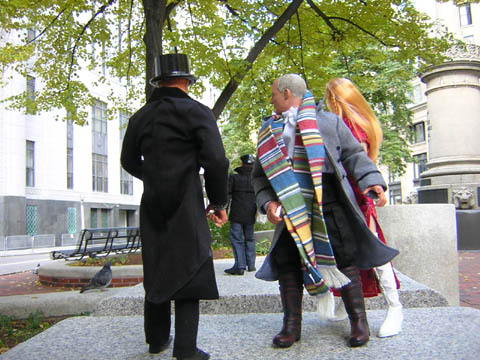
Boston Street
(Click for larger image)
To shoot this story, I actually had to have three of the Falcon aquarium ornaments. One left as stone-colored, and two painted black (for the scene where the two are swapped in Spade's office.) But a fourth had to be made as well. I cut a rough shape from styrofoam and painted it black so I could wrap it in paper and string for Jacobi to carry easily. It worked rather well.
I didn't recreate Spade's office accurately from the film. It wouldn't work for my story. His office has an anteroom where his secretary, Effie Perrine, sits. The hall door opens into this space. Then there's an office inside that which is Spade's private office. This is where his desk would be. But in my story Jacobi enters the one and only room and collapses dead by the desk after depositing the bird. In the film and the book, Jacobi enters, gives Effie the Maltese Falcon and dies.
This doesn't fit well with my story as by now Spade is out looking for Brigid O'Shaugnessy when Jacobi shows up and dies while Effie is in the office. Spade returns and tells Effie to call the police. He takes the bird and leaves, to put it into safe storage. I didn't have time to do that in this story so I just didn't.
This one was more for me than for the flow of the story. It brings in the character of the Falconer, gives me the opportunity to inject a little humor, and introduces a time paradox that I quite like.
In making the hallway and Spade's office I probably spent over a hundred bucks. Just for paint, rollers, moulding, glue, wallpaper, (Yes, that's a wallpaper border as wainscotting), balsa wood for the doors, beads for the doorknobs, etc. I had to buy a miter box and saw, etc. It adds up. I didn't keep close accounting, but it had to have climbed up to the near hundred buck mark by the time I had the desk done and the light fixtures and decorations that I didn't already have.
And the moulding I used on the outside hallway was thicker than the moulding used for the doorframe inside. I wanted to have the interior look a little different than the hallway. But in doing this I inadvertently made the window above the door lower than outside.
I toyed with various ideas for hallway lighting, but settled on dome-like caps from a Hamster Habitrail modular set. There was a piece that had several of these caps on it. I simply painted the caps white, with brown trim, and it worked rather well.

Habitrail Space Cube
(Click for Larger Image)
The floor of the hallway and office was a happy accident. I often use the boardroom tables at my office to shoot on, and one of the rooms had this table with a fine printed wood-grain top. It completes the look for the hallway.
The office doors are made of balsa panels cut and glued together over a black piece of foam-core. The windows are frosted plastic I found. A homework binder, I believe. I used real hinges on Spade's door, hinges found on a small wooden craft box that can be found in any Michael's store. I printed Spade's door text on clear plastic sticker sheet, cut it and stuck it to the door window.
Down the hall, you can see by these production shots that the name on the door is Philip Marlowe, Raymond Chandler's famous private detective, also played by Humphrey Bogart in the film "The Big Sleep". Sadly, this name is not visible in the final edit of the story because the figures in the hallway are constantly blocking it.

Hey... who is that behind the door?
(Click for larger version)
The desk was made from cedar and balsa wood, painted brown. But for the desk, I wanted as many things you would find on a detective's desk as possible. So I printed out a ton of paperwork, including a LIFE magazine, letters, photographs, a passport, books and diplomas and certificates for the walls.
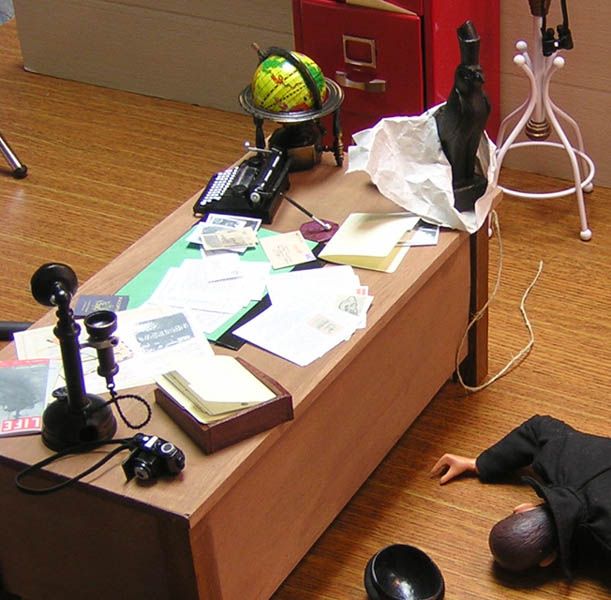
The Desktop Items
(Click for larger image)
I created a desk blotter, a pen set, an in-box, and files filled with paperwork. The rest of the desk was filled with scale items I had like the vintage telephone and typewriter, a globe, and on the file cabinet, an old phonograph, which was a Christmas ornament I've had for well over a decade.
I also created the water cooler by Spade's door. I took a "Red Bull" can and a small Poland Springs water bottle. I painted the can silver, and filled the bottle with water.
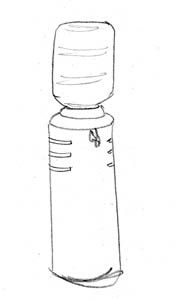 |
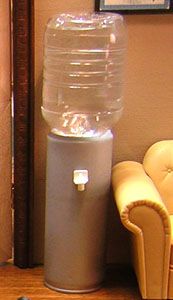 |
Water Cooler Concept |
WaterCooler Final |
The Falconer uses a Heavy Duty GI Joe head and body. He's wearing a GI Joe white t-shirt, pants from a Final Fantasy figure, and the overcoat from a Street Fighter figure. He is wearing the gauntleted hand of Sir Lancealot as a falconer's glove.
I use two hawk toys here. One is a standing hawk I borrowed from my daughter. The other is from an Adventures Of GI Joe set - "Challenge at Hawk River". I simply shot the flying hawk against the sky and then composited it into the shots where it is flying away from the Falconer's glove.
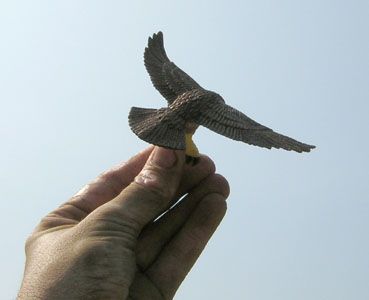
Hawk shot against sky
(Click for larger image)
All of the information the Falconer gives the Doctor is real info I dug up while researching the last few Egyptian Pharaohs. Here, the Falconer gives the background of the people the Doctor is about to meet.
The Falconer here performs the function of Hawk to Robert B. Parker's Spenser. Someone I know suggested that I would have done better to have used a "Benjamin Sisko" Star Trek: Deep Space Nine head-sculpt for the Falconer, and when he said that I said "Of course! d'OH!" Benjamin Sisko is played by Avery Brooks who also played Hawk in the TV series "Spenser". Oh, I missed the perfect homage! However, when that figure was in stores, I passed on him, even though he hung around at discount for years.
After completing work on the office hallway I thought I had done too much work and I was crazy for putting so much time and effort into these things. Then came the Egyptian palace set. Oy!
I bought two 2x8 foot styrofoam pink insulation sheets and cut them into two making eight 2x2 ft sections.
I then measured out lines on these pieces which would become the walls of the Egyptian palace, and made a cardboard template for the triangular designs for the base of the wall.
I found some heiroglyph phoneme guides online and used these to write things on the wall. No, the wall designs are not random. Each one says something meaningful, and if you really knew these phoneme characters you could read some hints about the story and some of the secrets involved.
Cartouches are enclosed lassos with characters inside. Cartouches always depict names. They have a base and look like bullet cartridges, which is how they got the french name "cartouche".
The heiroglyphs not surrounded by cartouches are just phrases. Some of them include cartouches where I use names of course. Some even fortell details of the story yet to come.
And of course standard Egyptian symbols of the jackals, scarabs, the Eye of Horus, the ankh, are all here.
 |
 |
 |
|
Elannuir
|
Edmund of Sussex
|
The Second Key
|
 |
 |
 |
|
Nektanebo II
|
Le Maitre
|
Doctor Who
|
But perhaps you don't notice some of the other "heiroglyphs". Like Pac Man chasing down Ghosts, or Joust birds. Even Q*Bert makes an appearance, though he may not be visible in the final shots.
 |
 |
 |
 |
|
S.H. and Pac Man
|
Doctor Who; Pac Man; S.H.
|
Q*bert; The Key to Time; The TARDIS; The Second Key
|
Heiroglyphs Suck
|
To paint these onto the stone wall I had a plan. I wanted the characters to be in relief on the etched stone. To achieve this effect I first painted the pink styrofoam with white acryllic paint. Then, when it dried, I spraypainted the styrofoam with silver or white paint (whatever I had handy.) Spray paint eats away at styrofoam, but not the paint laid down beforehand. It creates an effect that is similar to sandblasting, though you have to be careful. Concentrated spraypaint will eat into the styrofoam rather harshly, so you want to be subtle here. I had one or two walls that were far too etched. So much so that the paint ate away at the areas that were supposedly safely covered with water paint.

White paint over the styrofoam
(Click for larger version)
But the effect worked rather well making a roughly etched design.
Then I used styrofoam rollers and craft paint to roll on yellow ochre paint. I originally wanted to use sandstone colored paint but could not find a large enough stock. I needed quite a bit of paint. Plus, the walls of Spade's office were sandstone and I didn't want the two sets to look similiar, chromatically.
Then I realized I'd need a floor. The tables at my office weren't going to cut it for what I wanted to do. I normally use our various boardroom tables for floors, like the wood floor of Spade's office and hallway, or the nicely mottled marble I use for some other stories. I even used the blue felt surface of our pool table for one story, "The Adventure Team and the Polar Rover".
But I wanted a stone floor that matched the walls. I bought one more piece of 2x8 styrofoam, cut a 2 foot square piece off and formed a "T" shaped TETRIS piece. Then I used a soldering iron to etch out the spaces between the stones. I liked the pattern I created in the central piece which led to normal stone flags on each of the wings. I did some spray-paint "wear" on the floor, then roller-painted it.
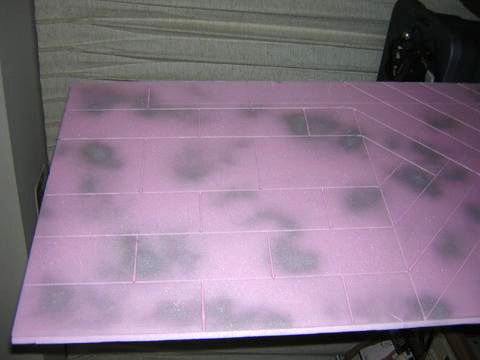
Floor Piece (Before Paint) Spray-paint used
to etch the floor
Click for larger image
The columns were cut from a long cardboard tube I found out by our dumpster one day. I knew I'd have a use for it so I snagged it. I cut the thick cardboard with a carpet knife by just cutting around in a circle until I cut deep enough to cut all the way through. Typically, Egyptian columns are fluted. They widen at the center, and taper at the top. Mine, sadly, are cylindrical. They are usually topped with a flower pattern, but as you don't see the ceiling here, that's left to the imagination.
I used two pre-formed wooden bases I got at a craft store, painted the same yellow ochre for the pillar bases. Then I painted the pillars yellow ochre and painted the same red/blue borders on it as well as heiroglyphs and the eye of Horus and the ankh symbols.
Little Teos' bed is a piece from one of the "The Mummy" playsets from about 5 or 6 years ago. The cat godess, Bastet, also came from that set. The stone pillar is a piece of rough styrofoam (packing material for something I had) painted the same yellow ochre.
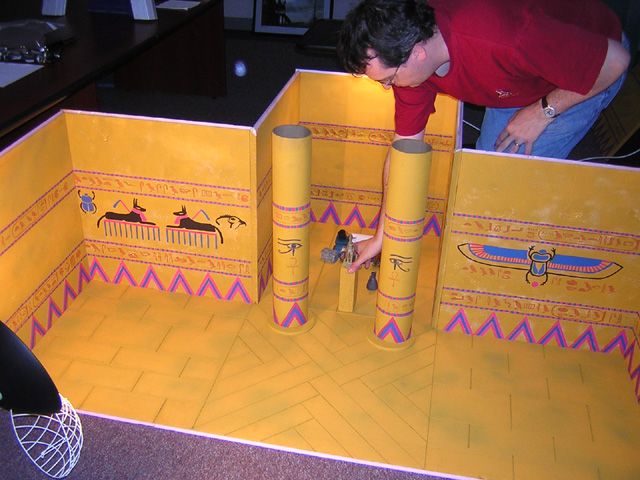
The Egyptian Palace - Set Up
Click for larger image
I tell you, it took over two solid weeks of work to put this set together in the confined space of my apartment and all of my other responsibilities and duties. This is why I can't churn out one of these chapters per month!
Hopefully this will be the last piece that requires two sets.
Udjashu was the wife of Nectanebo, the father of Teos. Teos, in line for the Pharaohs throne, never gets to rule. As the Falconer says, his throne is usurped by Nahkthorheb who then called himself Nectanebo II. So here you see little Teos, doomed never to rule, and his mother, Udjashu. This all happened circa 380 B.C.
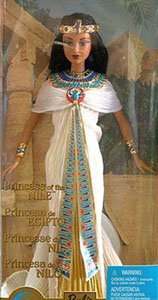
Udjashu is a Princess of the World Barbie head on a Geri (Get Real Girls) body. The dress and head-dress as well as chest decoration are all from the Barbie. It was seeing this gorgeous face that made me want to set a part of this story in Egypt.
Teos is a Barbie toddler. He came in a set with a father figure which I gave to my daughter. (I later gave Teos to my daughter as well). I believe most royal Egyptian children had shaved heads, but I couldn't find a figure that fit, so Teos has a shaggy head of hair. It's ok. We don't see much of him anyway.
His bedroom is decorated with clay water jugs, a sculpture of Bastet, the cat god, and of course Horus on a pillar.
I think the Doctor got away with theft at the swap, but hey, all's fair in love and quests from the White Guardian, no? Even though he blatantly lied to Udjashu about the statue of Horus making the child better, at least he wasn't doing any damage to the child by removing the supposed statue of good luck.
The statue was carved in Malkata, which is a name I searched for. I wanted to call this story "The Cairo Falcon" or something... enough to link it to "The Maltese Falcon". Then I found that Malkata was the city of Amenhotep III's palace, which was perfect. Hence, "The Malkatese Falcon"
Keep in mind that the statue of Horus is stone-colored. So if you believe the story of how the Horus statue got to Spade's office (following the story from "The Maltese Falcon") it got enamelled somewhere along the way before it reaches Spade's office for the switch. This is because in "The Maltese Falcon", the jeweled falcon was coated in enamel to hide its jeweled surface.
Again, I try not to think too much about this whole Falcon time paradox because it hurts my brain.
The mysterious woman shows up again after the Doctor has left. She appears in a kind of portal doorway.
The Portal is also made of that oh-so-versatile and easy-to-work-with styrofoam insulation. I cut the two side pieces and the lintel out of the styrofoam and fitted them together. I cut the two base pieces on a bias. I used white glue to join the pieces. Then I started painting. The little rivets are done in two ways: On the frame of the portal those are small brass studs I found at a craft store. These are the same studs that are on the skirt of Elannuir's primitive armor outfit, painted silver. On the door I used drops of Elmer's White Glue, let dry, and painted.
Concept for
the Portal Doorway Click for larger image |
Final Portal
Doorway Click for larger image |
The doorway is done in two ways: The closed door is one solid piece of black foam-board. The open door was originally made of one piece then cut into three. Each was masked and painted with silver border with white glue "rivets". Then I painted the strips. I dry-brushed some silver on the black surfaces of the doors for wear.
The light was found in a car parts place. It's just a blue-colored rectangular housing over a light bulb. The bulb wasn't bright enough with a 9V battery so I used a tap-light to create a switched system with a simple round light bulb. I put a simple section of white paper inside the blue "dome" to diffuse the light better. Originally you could see a bright center for the blue light which was the little bulb. This way it appears more spread out and I like the way the light hits the frame of the portal.
Hmmmm... who could this mysterious woman who emerges from this Time Doorway be?

The Locator - made from Lego pieces
On Sunday, October 31, 2004, Halloween, and the day after the Red Sox parade, Sean Dickinson and I went to Boston to shoot pages 3 and 4 of this story - the city. We parked on the south side of Boston and shot the opening shots there in a loading bay. Then we went across a bridge and shot the Captain near the waterfront, but those shots didn't work out well. It was only a stand-by anyway. We intended to shoot the Captain shots at Rowe's Wharf.
Walking up past South Station we went into the Financial District. Down an alleyway I found the perfect building for Sam Spade's office. I shot the Captain looking at the building from two angles, and I shot him in front of the doorway. Then I shot the Doctor with locator pointing at the building.
I was getting ready to shoot the shot of the trio running towards Spade's office. I had found a convenient building ledge on which I could place the figures for posing. I was posing the Doctor, running with locator in hand, when the locator slipped from the Doctor's hand, down to the ledge, and down to the sidewalk.
Uh-oh. I was standing on a grate.
The locator bounced around the grate a bit as I frantically tried to prevent the inevitable... the locator plunged down into darkness.
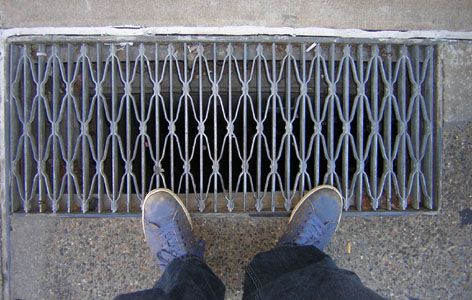
Yep... the Locator is down there... somewhere.
I lost the locator.
But as I didn't really need it for that shot, it was ok. I could get a new locator easily enough. Just need to find another lego post and several translucent circle pieces. I'm sure that won't be too much of an issue.
Then I realized: If you watch the original "The Key to Time" on DVD with the commentary text on, it tells you that during the shooting of one of the episodes of the Key to Time, I think it was episode three, they lost their locator. Another one had to be built to continue filming!
Wow. I call that a momentous coincidence.
But just to let you know, replacing the locator was not easy. Finding white posts is harder than finding hens' teeth. It took months before I accidentally happened upon a Lego soccer set with several players, and gear to play soccer. For goal posts and other aparatus, they had four white Lego posts. Bingo! I was able to find more clear circles of various colors, and I finally replaced the locator.
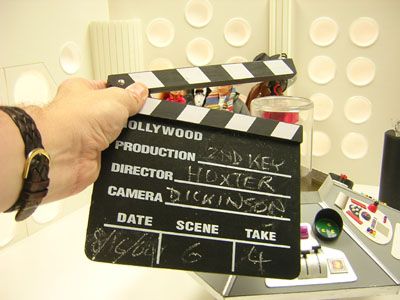
Slate!
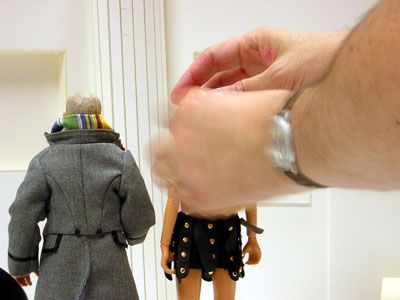
Settin' 'em up
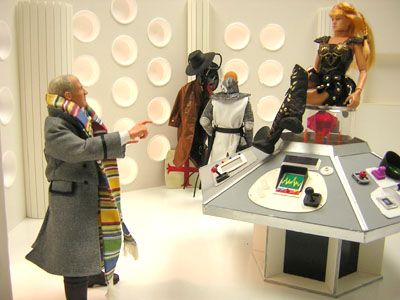
"Get down from there!"